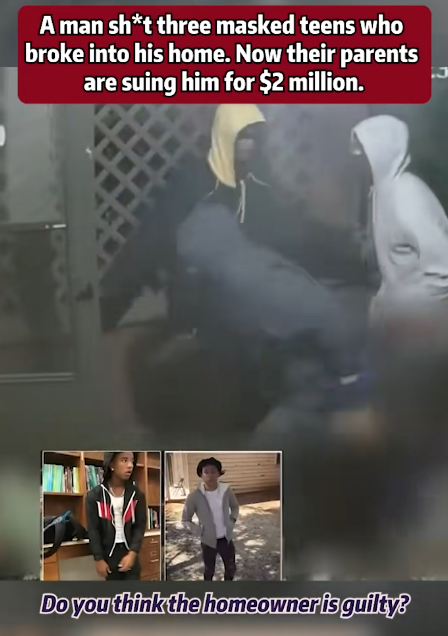“Homeowner Fires at Masked Teens During Break-In — Now Parents Are Suing Him for $2 Million”
A viral security video has ignited a national debate after a homeowner opened fire on three masked teenagers who allegedly broke into his home — and is now facing a massive $2 million lawsuit filed by the teens’ parents. The case has quickly become one of the most controversial self-defense stories online, with millions arguing over who is truly at fault.
The footage shows what appears to be three masked individuals rushing onto a porch late at night. Their faces are covered, their movements quick and frantic. According to early reports circulating online, the homeowner heard the commotion, believed his life was in danger, and grabbed a legally owned firearm. Moments later, shots were fired, ending the confrontation abruptly.
Police were called, and the teens — all under 18 — were found with injuries but survived. While the homeowner claimed he acted in self-defense, insisting he feared the masked intruders were armed and dangerous, the parents of the teens say he used excessive force and should be held financially accountable.
The lawsuit quickly triggered outrage, confusion, and intense public reaction.
Online, people are sharply divided:
Supporters of the homeowner argue:
- “If someone breaks into your home at night wearing masks, you have every right to defend yourself.”
- “He didn’t know their age. They looked like adults in hoodies and masks.”
- “Parents should focus on why their kids were out committing crimes, not suing the victim.”
Others, however, see the situation differently:
- “Using a gun on teens was too extreme.”
- “Property can be replaced — lives can’t.”
- “Parents suing is understandable if they believe excessive force was used.”
Legal experts are also weighing in. Whether the homeowner is guilty or not depends heavily on local self-defense laws, often called “Stand Your Ground” or “Castle Doctrine” laws. In many regions, homeowners can legally use force — sometimes even deadly force — if they reasonably believe they are in imminent danger.
But there’s a key phrase: reasonably believe.
This is where the lawsuit targets the homeowner. The parents argue that the teens were unarmed, that the homeowner acted too quickly, and that he could have called police rather than firing. The homeowner, however, insists the masked teens lunged toward him, making him fear for his life in that split second.
The case raises complicated ethical and legal questions:
1. Does age matter when the homeowner had no way to know?
At night, in masks, height and clothing can make teens appear older or more threatening.
2. Should breaking into someone’s home automatically justify armed self-defense?
Many believe yes. Others say only if the intruders are armed.
3. Are parents right to sue?
Some see it as outrageous — others say they are protecting their children’s future.
As images of the teens circulate online — shown smiling in everyday clothes — the emotional weight of the situation grows even heavier. People are forced to see them not as faceless intruders, but as kids who made a terrible decision with life-altering consequences.
Meanwhile, the homeowner’s supporters point to the terrifying reality of home invasions and the split-second decisions ordinary people must make when fear takes over.
The lawsuit could take months to resolve, but one thing is clear: this story has struck a chord because it sits at the intersection of safety, responsibility, youth, and the right to defend one’s home.
